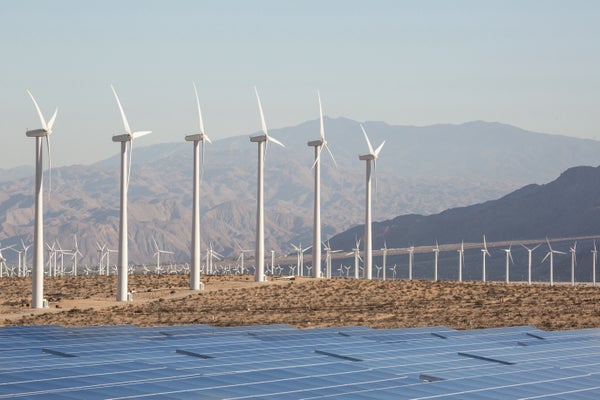August 13, 2024
3 min read
U.S. Wind and Solar Are on Track to Overtake Coal This Year
Two renewable resources, wind and solar, together have produced more power than coal through July—a first for the U.S.
Wind turbines spin near rows of solar panels in the California desert.
thinkreaction/Getty Images
CLIMATEWIRE | Wind and solar generated more power than coal through the first seven months of the year, federal data shows, in a first for renewable resources.
The milestone had been long expected due to a steady stream of coal plant retirements and the rapid growth of wind and solar. Last year, wind and solar outpaced coal through May before the fossil fuel eventually overtook the pair when power demand surged in the summer.
But the most recent statistics showed why wind and solar are on track in 2024 to exceed coal generation for an entire calendar year — with the renewable resources maintaining their lead through the heat of July. Coal generation usually declines in the spring months, due to falling power demand and seasonal plant maintenance, and picks up when electricity demand rises in the summer.
On supporting science journalism
If you’re enjoying this article, consider supporting our award-winning journalism by subscribing. By purchasing a subscription you are helping to ensure the future of impactful stories about the discoveries and ideas shaping our world today.
Renewables’ growth has been driven by a surge in solar production over the last year. The 118 terawatt-hours generated by utility-scale solar facilities through the end of July represented a 36 percent increase from the same time period last year, according to preliminary U.S. Energy Information Administration figures. Wind production was 275 TWh, up 8 percent over 2023 levels. Renewables’ combined production of 393 TWh outpaced coal generation of 388 TWh.
“I think it is an important milestone,” said Ric O’Connell, who leads GridLab, a clean electricity consulting firm. “I think you’re seeing a solar surge and a coal decline and hence the lines are crossing.”
EIA previously reported that renewable generation eclipsed coal in 2020 and 2022 and then repeated the feat in 2023. But those figures notably included other resources such as hydropower. Now wind and solar are posed to overtake coal on their own. The pair accounted for 16 percent of U.S. power generation through July, slightly more than coal’s share of the power generation market.
The development comes at a time when the reliability of the electric grid is in the spotlight amid increasing power demand due to the growth of artificial intelligence, data centers, and more frequent and severe heat waves — which drive up air conditioning use. EIA statistics show electricity demand through the first seven months of the year was up 4 percent to 2,436 TWh through the end of July.
The growth in demand has been a boon for power generators. Nuclear generation was 459 TWh through July, a 3 percent increase helped by two new reactors in Georgia coming online within the last year. Hydro was up a slight 1 percent to 159 TWh. Gas has been particularly important for supplying additional demand, increasing 5 percent over 2023 levels to 987 TWh.
Mark Repsher, an analyst who tracks the power industry at PA Consulting Group, said the figures point to larger challenges facing the power grid. Additional power plants that can be turned on at the flip of a switch will be needed to meet demand, he said. The question is whether it will come from natural gas or zero-carbon resources, such as nuclear or geothermal.
“Renewables will continue to be a huge part of the industry, but I think there will be an inflection point where the incremental value of an additional megawatt-hour from renewables will be less than some other alternatives,” he said.
Others were less sure. The rapid growth of wind, solar and batteries in Texas shows that renewables can be built quickly and stabilize the electric grid, said O’Connell. The state is “sailing through a crazy summer” thanks to record wind, solar and battery output, he said.
Coal may yet hold off wind and solar with a strong five months to close 2024. But renewables are likely to overtake the former king of the power sector sooner rather than later.
The last coal plant built in the continental United States came online in 2013. American coal capacity then declined 38 percent over the following decade.
Renewables, meanwhile, are booming. The U.S. installed almost 12 gigawatts of new solar capacity through June, meaning 2024 already ranks as the third best year for U.S. solar installations with six more months to go. Another 25 GW is planned to come online this year, according to EIA. Wind added 2.5 GW through June and is expected to install another 4.5 GW by the end of the year.
One piece of positive news for the coal industry is that plant retirements are on track to hit their lowest level in 13 years. EIA projects 3.2 GW of coal capacity will close this year, the lowest annual retirement figure since 2011 and down from the 9.5 GW of coal capacity shut down last year.
Reprinted from E&E News with permission from POLITICO, LLC. Copyright 2024. E&E News provides essential news for energy and environment professionals.

